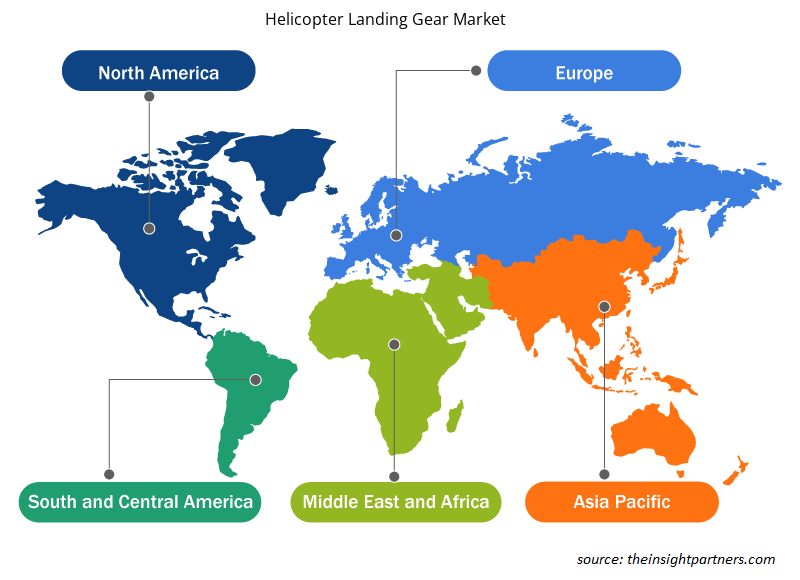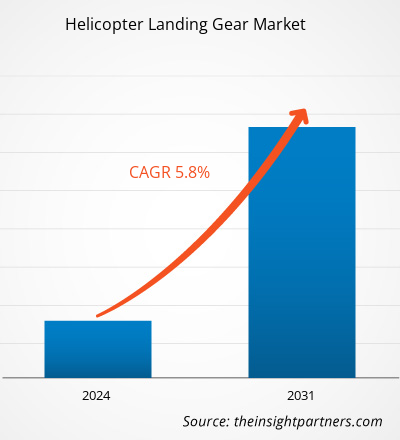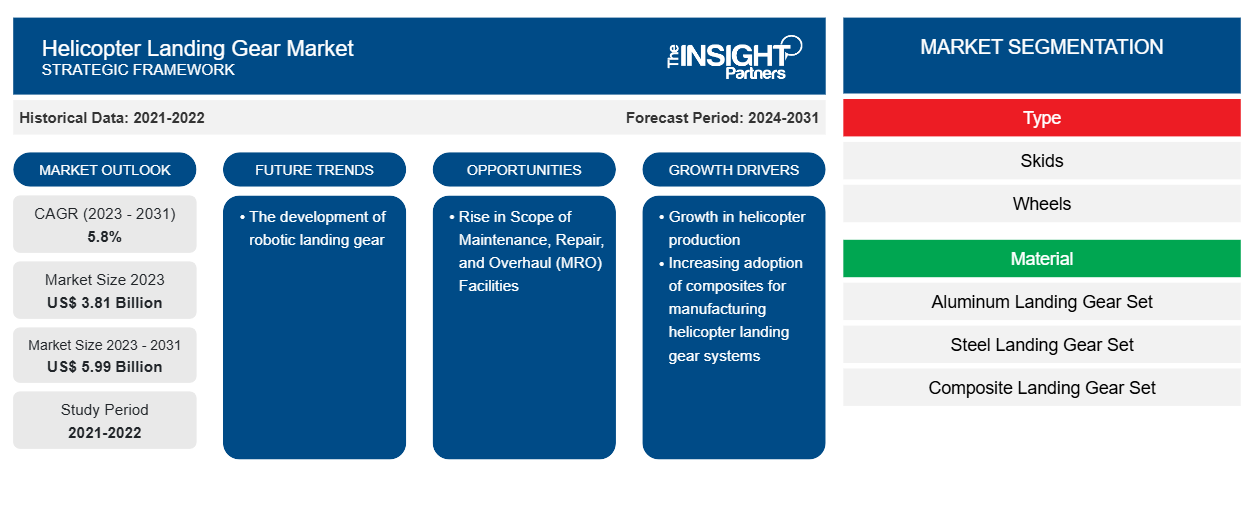Se prevé que el tamaño del mercado de trenes de aterrizaje para helicópteros alcance los 5.990 millones de dólares en 2031, frente a los 3.810 millones de dólares en 2023. Se espera que el mercado registre una CAGR del 5,8 % durante el período 2023-2031. Es probable que el desarrollo de trenes de aterrizaje robóticos siga siendo una tendencia clave en el mercado.
Análisis del mercado de trenes de aterrizaje para helicópteros
La industria mundial de fabricación o reacondicionamiento de helicópteros se caracteriza por la presencia de fabricantes de helicópteros conocidos y financieramente fuertes como Airbus y Bell Helicopter. Debido a esto, el poder de negociación de los compradores en el mercado de trenes de aterrizaje para helicópteros es bastante alto en la actualidad, sin embargo, se estima que el poder de negociación de los compradores se reducirá a un nivel moderado en los próximos años. Las empresas de fabricación de helicópteros como Airbus, Bell Helicopters, Sikorsky Aircraft Corporation, entre otras, tienen una feroz rivalidad competitiva entre sí y requieren una mejora constante en sus aeronaves para mantener su posición de liderazgo en el mercado. Debido a este hecho, estas empresas tienen una alta tendencia a cambiar de contratistas de componentes de helicópteros durante un período de tiempo, con el fin de mejorar todos los sistemas del helicóptero. Por lo tanto, debido a la naturaleza consolidada de la industria de fabricación de helicópteros con la presencia de unos pocos grandes fabricantes de helicópteros, se espera que el poder de negociación de los compradores se mantenga alto en los próximos años.
Descripción general del mercado de trenes de aterrizaje para helicópteros
El mercado de trenes de aterrizaje para helicópteros está formado por un gran número de empresas consolidadas y reconocidas, como Safran SA, Liebherr Group, Héroux-Devtek Inc., Circor International, Inc. y Triumph Group Inc., entre muchas otras. Estos actores del mercado tienen una posición de marca consolidada y una presencia a largo plazo en el mercado mundial de trenes de aterrizaje. Los fabricantes de helicópteros dependen en gran medida del valor de marca de los fabricantes de componentes para helicópteros y, debido a esto, la mayoría de los contratos se otorgan a los fabricantes de trenes de aterrizaje para helicópteros establecidos y reconocidos en la industria, creando así un espacio mínimo para que nuevos fabricantes entren en el mercado. Además de esto, las inversiones de capital iniciales necesarias para entrar en el mercado de trenes de aterrizaje para helicópteros son bastante altas, lo que actúa como una barrera de entrada para los nuevos participantes.
Personalice este informe según sus necesidades
Obtendrá personalización en cualquier informe, sin cargo, incluidas partes de este informe o análisis a nivel de país, paquete de datos de Excel, así como también grandes ofertas y descuentos para empresas emergentes y universidades.
- Obtenga las principales tendencias clave del mercado de este informe.Esta muestra GRATUITA incluirá análisis de datos, desde tendencias del mercado hasta estimaciones y pronósticos.
Factores impulsores y oportunidades del mercado de trenes de aterrizaje para helicópteros
Aumento de la producción mundial de helicópteros
El aumento de la producción y entrega de helicópteros en todo el mundo es uno de los principales factores que respaldan la adopción de trenes de aterrizaje para helicópteros civiles y militares en diferentes regiones del mundo. Por ejemplo, según la Asociación de Fabricantes de Aviación General (GAMA), en 2022 se entregaron alrededor de 1072 helicópteros civiles en comparación con los 1007 helicópteros de 2021. Además, según GAMA, las entregas de helicópteros de pistón experimentaron un crecimiento de alrededor del 7,7% en 2023 con 209 unidades entregadas en todo el mundo; mientras que los helicópteros de turbina civiles y comerciales experimentaron un aumento de alrededor del 9,9% con 811 unidades en 2023. Este crecimiento en las entregas y la producción de helicópteros está impulsando el crecimiento del mercado de trenes de aterrizaje para helicópteros en todo el mundo.
Aumento del alcance de las instalaciones de mantenimiento, reparación y revisión (MRO)
El crecimiento exponencial de los helicópteros ha complementado el establecimiento de instalaciones de MRO en el mundo a lo largo de los años. Se espera que el alcance de las instalaciones de MRO aumente en diferentes partes del mundo, especialmente en Asia. Debido a la creciente adopción de helicópteros civiles para diversos fines comerciales, como la lucha contra incendios forestales, la facilitación de la cobertura de noticias y tráfico, la realización de misiones de búsqueda y rescate y el patrullaje de gasoductos y oleoductos, el establecimiento de instalaciones de MRO también está experimentando una tendencia positiva. El aumento del uso de helicópteros está acelerando rápidamente el alcance del negocio de mantenimiento de helicópteros. Países como Singapur e India están presenciando la presencia de empresas que ofrecen servicios de MRO asociados al tren de aterrizaje de helicópteros. Tentacle Aerologistix Pvt. Ltd. ha entrado en el área de MRO con el objetivo de crear un hito en el mantenimiento de aeronaves. Además, varios países emergentes también han anunciado sus planes de establecer un centro de MRO en sus respectivas regiones. Por ejemplo, el gobierno indio ha anunciado que convertirá al país en un centro de MRO de aviación, lo que se espera que impulse aún más la demanda de sistemas de tren de aterrizaje de helicópteros en toda la región.
Informe de mercado de trenes de aterrizaje para helicópteros Análisis de segmentación
Los segmentos clave que contribuyeron a la derivación del análisis del mercado de trenes de aterrizaje de helicópteros son el tipo, el material y la aplicación.
- Según el tipo, el mercado de trenes de aterrizaje para helicópteros se divide en patines y ruedas. El segmento de patines tuvo una mayor participación de mercado en 2023.
- Según el material, el mercado de trenes de aterrizaje para helicópteros se segmenta en trenes de aterrizaje de aluminio, trenes de aterrizaje de acero, trenes de aterrizaje compuestos y titanio . El segmento de compuestos tuvo una mayor participación de mercado en 2023.
- Según la aplicación, el mercado de los trenes de aterrizaje para helicópteros se divide en helicópteros civiles y helicópteros militares. El segmento de los helicópteros militares tuvo una mayor participación de mercado en 2023.
Análisis de la cuota de mercado de los trenes de aterrizaje para helicópteros por geografía
El alcance geográfico del informe de mercado de trenes de aterrizaje de helicópteros se divide principalmente en cinco regiones: América del Norte, Europa, Asia Pacífico, Medio Oriente y África, y América del Sur.
En 2023, América del Norte dominó el mercado, seguida de Europa y la región de Asia Pacífico. Además, es probable que Asia Pacífico también experimente la CAGR más alta en los próximos años. Estados Unidos dominó el mercado de trenes de aterrizaje para helicópteros de América del Norte en 2023. La Fuerza Aérea de Estados Unidos es una de las fuerzas armadas más poderosas y tecnológicamente avanzadas del mundo. El gobierno estadounidense invierte constantemente en el desarrollo de una base industrial de defensa en el país, debido a un enfoque significativo en la expansión de las capacidades militares como prioridad estratégica. En 2023, el gasto militar de Estados Unidos se situó en 916.000 millones de dólares, un aumento del 4,4 por ciento respecto al año anterior. Se prevé que Estados Unidos sea el mayor contribuyente a los ingresos en el mercado mundial de trenes de aterrizaje para helicópteros debido al continuo gasto en I+D para fortalecer el sector militar, así como a la presencia de algunos de los principales fabricantes de helicópteros de combate y trenes de aterrizaje. CIRCOR Aerospace y Safran se encuentran entre los principales fabricantes que operan en el mercado de trenes de aterrizaje de Estados Unidos. Por lo tanto, se espera que el mercado de trenes de aterrizaje para helicópteros crezca durante el período proyectado como resultado de los factores mencionados anteriormente.
Alcance del informe de mercado de trenes de aterrizaje para helicópteros
Perspectivas regionales del mercado de trenes de aterrizaje para helicópteros
Los analistas de Insight Partners explicaron en detalle las tendencias y los factores regionales que influyen en el mercado de trenes de aterrizaje para helicópteros durante el período de pronóstico. Esta sección también analiza los segmentos y la geografía del mercado de trenes de aterrizaje para helicópteros en América del Norte, Europa, Asia Pacífico, Oriente Medio y África, y América del Sur y Central.

- Obtenga datos regionales específicos para el mercado de trenes de aterrizaje para helicópteros
Alcance del informe de mercado de trenes de aterrizaje para helicópteros
| Atributo del informe | Detalles |
|---|---|
| Tamaño del mercado en 2023 | US$ 3.81 mil millones |
| Tamaño del mercado en 2031 | 5.99 mil millones de dólares estadounidenses |
| CAGR global (2023 - 2031) | 5,8% |
| Datos históricos | 2021-2022 |
| Período de pronóstico | 2024-2031 |
| Segmentos cubiertos | Por tipo
|
| Regiones y países cubiertos | América del norte
|
| Líderes del mercado y perfiles de empresas clave |
|
Densidad de actores del mercado de trenes de aterrizaje para helicópteros: comprensión de su impacto en la dinámica empresarial
El mercado de trenes de aterrizaje para helicópteros está creciendo rápidamente, impulsado por la creciente demanda de los usuarios finales debido a factores como la evolución de las preferencias de los consumidores, los avances tecnológicos y una mayor conciencia de los beneficios del producto. A medida que aumenta la demanda, las empresas amplían sus ofertas, innovan para satisfacer las necesidades de los consumidores y aprovechan las tendencias emergentes, lo que impulsa aún más el crecimiento del mercado.
La densidad de actores del mercado se refiere a la distribución de las empresas o firmas que operan dentro de un mercado o industria en particular. Indica cuántos competidores (actores del mercado) están presentes en un espacio de mercado determinado en relación con su tamaño o valor total de mercado.
Las principales empresas que operan en el mercado de trenes de aterrizaje para helicópteros son:
- Circor Aerospace Inc
- Sistemas de interplantación Sika Limited
- DART AEROESPACIAL
- Eurocarbon BV
- Trelleborg
- Rostec
Descargo de responsabilidad : Las empresas enumeradas anteriormente no están clasificadas en ningún orden particular.

- Obtenga una descripción general de los principales actores clave del mercado de trenes de aterrizaje para helicópteros
Noticias y desarrollos recientes del mercado de trenes de aterrizaje para helicópteros
El mercado de trenes de aterrizaje para helicópteros se evalúa mediante la recopilación de datos cualitativos y cuantitativos a partir de una investigación primaria y secundaria, que incluye publicaciones corporativas importantes, datos de asociaciones y bases de datos. A continuación, se enumeran algunos de los avances en el mercado de trenes de aterrizaje para helicópteros:
- Safran Landing Systems está a bordo del programa de aviones de rotor basculante de Bell, como parte del proyecto Future Long-Range Assault Aircraft (FLRAA) del ejército de los EE. UU. Según el contrato, Safran Landing Systems diseñará y desarrollará el sistema de aterrizaje totalmente integrado. Estos esfuerzos compartidos establecerán bases sólidas para cumplir con todos los requisitos futuros. (Fuente: Safran, comunicado de prensa, septiembre de 2023)
- Trelleborg Sealing Solutions lanza su material compuesto Orkot® C620, desarrollado específicamente para satisfacer las necesidades de la industria aeroespacial, en particular el requisito de un material resistente y ligero para soportar las elevadas cargas y tensiones a las que están sometidos los trenes de aterrizaje. (Fuente: Trelleborg Sealing Solutions, comunicado de prensa, febrero de 2022)
Informe sobre el mercado de trenes de aterrizaje para helicópteros: cobertura y resultados
El informe “Tamaño y pronóstico del mercado de trenes de aterrizaje para helicópteros (2021-2031)” proporciona un análisis detallado del mercado que cubre las siguientes áreas:
- Tamaño del mercado de trenes de aterrizaje de helicópteros y pronóstico a nivel global, regional y nacional para todos los segmentos clave del mercado cubiertos bajo el alcance
- Tendencias del mercado de trenes de aterrizaje para helicópteros, así como dinámicas del mercado, como impulsores, restricciones y oportunidades clave
- Análisis detallado de las cinco fuerzas de Porter
- Análisis del mercado de trenes de aterrizaje para helicópteros que abarca las tendencias clave del mercado, el marco global y regional, los principales actores, las regulaciones y los desarrollos recientes del mercado
- Análisis del panorama de la industria y de la competencia que abarca la concentración del mercado, el análisis de mapas de calor, los actores destacados y los desarrollos recientes del mercado de trenes de aterrizaje para helicópteros
- Perfiles detallados de empresas
- Análisis histórico (2 años), año base, pronóstico (7 años) con CAGR
- Análisis PEST y FODA
- Tamaño del mercado, valor/volumen: global, regional y nacional
- Industria y panorama competitivo
- Conjunto de datos de Excel
Informes recientes
Testimonios
Razón para comprar
- Toma de decisiones informada
- Comprensión de la dinámica del mercado
- Análisis competitivo
- Información sobre clientes
- Pronósticos del mercado
- Mitigación de riesgos
- Planificación estratégica
- Justificación de la inversión
- Identificación de mercados emergentes
- Mejora de las estrategias de marketing
- Impulso de la eficiencia operativa
- Alineación con las tendencias regulatorias





















 Obtenga una muestra gratuita para - Mercado de trenes de aterrizaje para helicópteros
Obtenga una muestra gratuita para - Mercado de trenes de aterrizaje para helicópteros